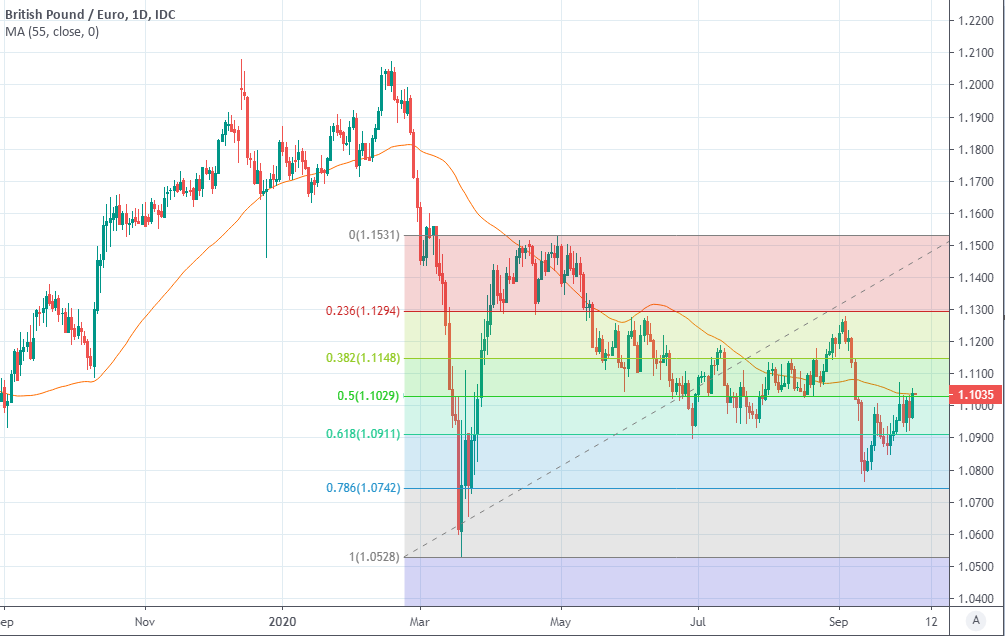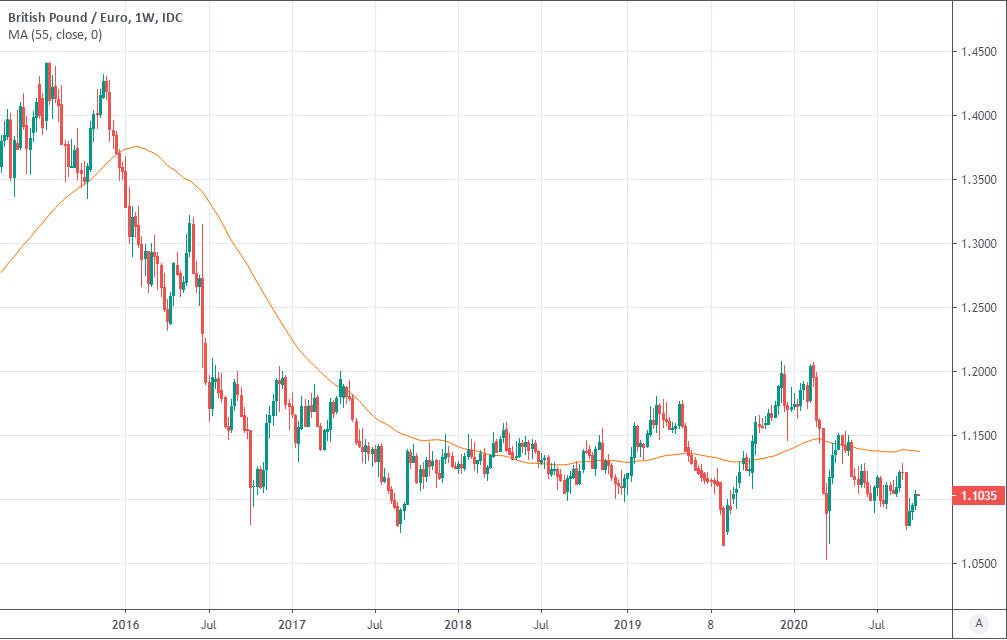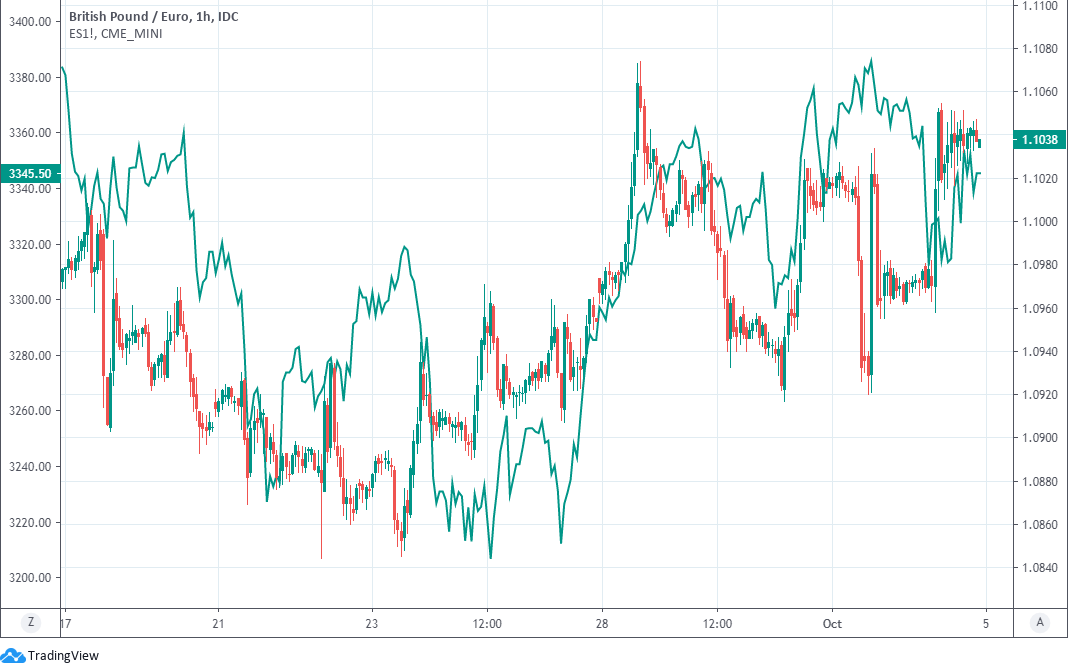Pound-Euro Week Ahead Forecast: Aiming Higher on Brexit Relief but Risking Another Range-trade
- Written by: James Skinner
-GBP/EUR in recovery mode as Brexit talks set to be extended.
-After outline of a deal said to be visible with talks at crucial stage
-'No deal' risk less palpable but risk appetite also key for outlook.
Image © Adobe Images
- GBP/EUR spot rate at time of writing: 1.1038
- Bank transfer rate (indicative guide): 1.0756-1.0833
- FX specialist providers (indicative guide): 1.0876-1.0943
- More information on FX specialist rates here
The Pound-to-Euro exchange rate is in recovery mode and could be on the cusp of a Brexit-inspired breakout from its recent range, but will have to overcome technical resistance and contend with deteriorating risk appetite this week.
Sterling recovered lost ground from the Euro amid reports of cautious optimism in London about the prospect of a Brexit trade deal being reached and after the EU remained at the negotiating table after an earlier deadline for the UK to abandon the Internal Market Bill, passed without that demand having been met.
The outline of a deal was said by British negotiator David Frost to be within reach on Friday.
"While we don’t look for a confirmation of a trade agreement (for that it is too early, in our view), no escalation in tensions and hints that negotiations are to continue should be enough to help the pound," says Petr Krpata, chief EMEA strategist for currencies and bonds at ING.
There was much back and forth last week that saw volatile swings in Sterling as investors responded to often contradictory headlines that did little to take away from the perception that Brexit risks might be shifting to the upside.
Anonymous British officials were reported Thursday to have become more optimistic about the odds of reaching a deal but EU sources were quick to pour cold water over claims of progress.
"The EU need to move further before an understanding can be reached. On fisheries the gap between us is unfortunately very large and, without further realism and flexibility from the EU, risks being impossible to bridge. These issues are fundamental to our future status as an independent country. I am concerned that there is very little time now to resolve these issues," Frost said.
Both sides called for intensified talks, while Prime Minister Boris Johnson expressed confidence in an interview with The Telegraph that an agreement is out there to be struck.
Brexit remains a key influence on the Pound but with the two sides still at the table, the risk of an acrimonious fallout at year-end may be receding again and potentially dimishing Sterling's liability for losses in the short-term.
"We see some way to go yet to reaching an EU-UK trade deal but as long talks continue the markets are likely to assume the best and that should provide GBP support next week," says Lee Hardman, a currency analyst at MUFG.
Above: Pound-to-Euro rate at daily intervals with 55-day average (orange) and Fibonacci retracements of March recovery.
Prime Minister Boris Johnson and European Commission President Ursula Von der Leyen discussed "next steps" at the weekend after trade talks ended without an agreement on Friday. Michel Barnier is expected to meet with Germany's Angela Merkel on Monday.
Trade talks may now be extended beyond the self-imposed mid-October deadline that coincides with the next European Council meeting, potentially ruling out an October escalation of no deal fears.
"Trade deals with non-EU countries have been replicated, firms have had time to prepare, several agreements are already in place, and temporary unilateral measures would ease the disruption," says Andrew Wishart at Capital Economics, of a no deal Brexit. "That said, if it turns out that the EU’s letter marked the start of a complete breakdown in relations, there could be an “uncooperative” no deal where existing agreements unravel and the onerous application of new customs rules disrupts trade. Even in an “uncooperative” no deal, we suspect that the disruption would be short-lived. And the economic fallout from any no deal will be small compared to the pandemic."
Both sides have indicated a resolve to persevere with the talks until the last minute, contrary to earlier suggestions by each that they could walk away from the table if progress was not forthcoming by October or if other conditions like the removal of offending clauses from the Internal Market Bill were not satisfied.
"The spotlight turns back to its 55-day average," says David Sneddon, head of technical analysis at Credit Suisse, referring to the EUR/GBP rate or inverse of the Pound-to-Euro rate. "A closing break below here would suggest we are set to see a more concerted move lower."
The Pound was left testing its 55-day moving-average at 1.1037 against the Euro on Friday but could rise as far as 1.1225 following a daily close above there, according to Credit Suisse's Sneddon.
Above: Pound-to-Euro rate at weekly intervals with 55-week average (orange).
"We cannot rule out a deeper sell off to the 2020 support line," says Karen Jones, head of technical analysis at Commerzbank. "However intraday Elliott wave counts are positive and we would allow for recovery."
Jones says a continued advance by Sterling up to 1.1171 cannot be ruled out for the days ahead and has warned clients betting against the Pound that a move above here would amount to a green light for a further recovery to 1.1281.
She's a seller of Sterling from 1.1013 and is looking for a fall to 1.0743 over the next one-to-three weeks. Whether the Pound advances above its 55-day moving-average or retreats from it depends as much on the mood among investors as it does the Brexit situation.
"The fog of uncertainty is likely to persist for the next several days to weeks as the President's health situation evolves but also how that may impact the election. With no fiscal deal in sight still, we think the backdrop favors USD firmness overall," says Mark McCormick, head of FX strategy at TD Securities.
If President Donald Trump's battle against coronavirus continues to lift the Dollar it could also weigh on stock markets and deprive the Pound-to-Euro rate of an opportunity to get above 1.1043.
"The political uncertainty after Trump’s COVID infection and potentially tighter COVID restrictions will keep US equity markets fragile and continue to provide support for the dollar," says MUFG's Hardman.
Trump's illness casts doubt over the timetable of the U.S. election and has already halted the downtrend in the safe-haven Dollar while sending stocks tumbling on Friday, but should investors choose to view the development as making a Democratic Party administration more likely then the Pound might be found rising as stock markets stabilise.
Above: Pound-to-Euro rate at hourly intervals alongside S&P 500 futures (green line, left axis).
"The President was first diagnosed with COVID-19 on the evening of Thursday, October 01 and had received Regeron's antibody cocktail on Friday, October 2nd," Trump's physician said on Saturday, after earlier describing him as "doing very well...not requiring any supplemental oxygen...resting comfortably," and beginning Remdesivir therapy.
"Daily volatility having subsided, this will act as a major brake, preventing a pronounced rebound of the pair over the next few trading sessions, especially since weekly indicators are falling back. Under these conditions, it is more likely that the pair will pull back," says Micaella Feldstein, an analyst at Natixis, tipping EUR/GBP for a continued fall and the Pound-to-Euro rate for an ongoing rise.
With intrigue over President Trump's health and its impact on investor confidence aside, the Pound and Euro will take direction this week from Bank of England and European Central Bank speeches as well as August GDP data from the UK. ECB President Christine Lagarde will address separate audiences at 09:35 and 14:00 Tuesday, and investors are likely to listen closely given the ECB's recent concern about strength in the Euro and Friday's lower-than-expected inflation numbers.
"The Sep 9-10 ECB minutes may therefore offer some insight into the ECB’s thinking and members' views on the strength of the euro," says ING's Krpata. " On the UK economic data front, August GDP and Industrial and Manufacturing production (all on Friday) should have a limited impact on sterling. It is all about the UK-EU trade talks."
The Pound-to-Euro rate's -6.1% 2020 fall has helped lift the trade-weighted Euro, increases in which are the subject of ECB unease, so any further complaints about the currency could be a source of support for Sterling early on this week. But Governor Andrew Bailey will speak at 08:25 Thursday and markets will listen closely given the BoE's ongoing consideration of negative interest rates as a policy tool and market expectation that the bank will likely announce more quantitative easing before year-end.
Bailey's speech comes ahead of August GDP data due out at 07:00 on Friday, which is expected to show the economy growing at a month-on-month pace of 4.6% that month, down from 6.6% in July. The data will influence market expectations of the UK economic recovery but is likely to be of lesser importance than usual given the focus on the Brexit talks and the fact that Downing Street has since retightened restrictions on activity in response to a second wave of coronavirus infections, risking a final quarter slowdown.







